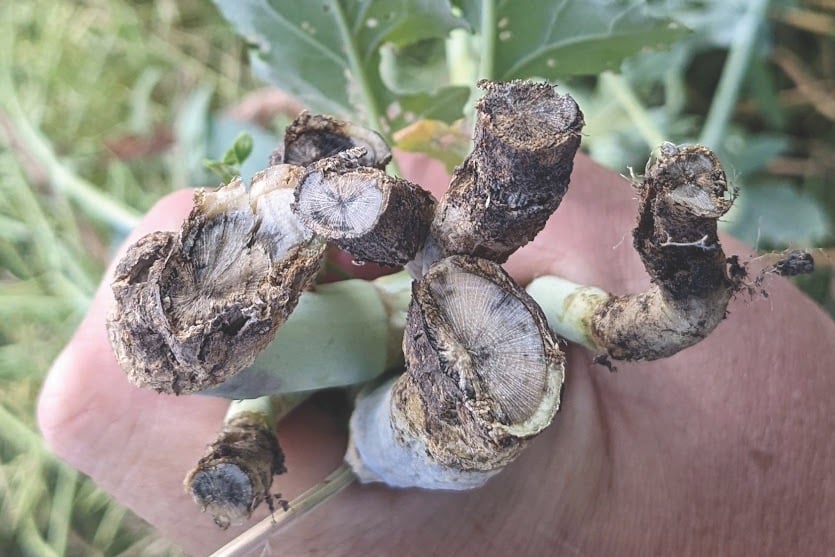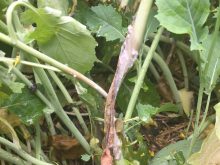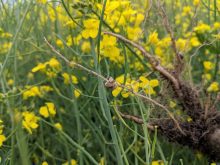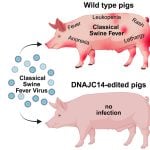Canola disease testing is available free of charge in much of the Prairies, but uptake among growers and agronomists remains relatively low, according to industry officials.
In Manitoba, the Pest Surveillance Initiative (PSI) lab has been offering free clubroot testing since 2014. The Manitoba Canola Growers Association lab also offers free blackleg and verticillium stripe testing as part of its #GetTested Program.
Despite being free to MCGA members, the program receives only 250 to 300 requests for testing from the province’s 7,500 canola growers and consultants in a typical year.
Read Also

Micronutrient applications compared in canola
An ongoing northeastern Saskatchewan trial looks at micronutrient applications, specifically boron, copper and zinc, to see whether those applications boost yield in canola crops.
“The number would be quite small at the moment,” concedes Sonia Wilson, research manager for the MCGA. “We are always encouraging more uptake. But it really depends on the management choices that growers are making and if they think that info would be helpful to them or not.”
In Saskatchewan, SaskCanola in conjunction with the Saskatchewan Ministry of Agriculture has been offering free blackleg and clubroot testing for the past several years. Verticillium stripe was added to the lineup this year.
The number of test requests from the province’s 17,000 canola producers ranges from 750 to 1,500 in a typical year, says Kaeley Kindrachuk, an agronomy extension specialist with SaskCanola. Those figures don’t include tests conducted as part of the province’s general canola disease survey or those for producers who submit their own samples to private labs.
Testing numbers in the province are higher for clubroot than blackleg, which Kindrachuk attributes to the fact that blackleg testing is a newer addition to the program.
Extreme dry conditions the province has endured in the past couple of seasons haven’t helped matters, she adds.
“Because it’s been very dry here the last couple of years, testing has been a bit lower, which is kind of understandable. When it’s dry, disease is not as top of mind for producers,” she says.
“We’re hoping now with verticillium being added, producers will take (more of) an interest again.”
While testing numbers remain relatively low in the province, Kindrachuk says they have increased each year since the free testing program was introduced.
The number of canola disease tests conducted in Alberta is difficult to track since no free public testing is offered and tests are only conducted upon request at private labs.
Keith Gabert, an agronomy specialist with the Canola Council of Canada who covers the central Alberta region, says clubroot testing is “relatively common” in the province based on what he has seen. However, blackleg race testing numbers continue to be low.
“I get the impression that it wouldn’t take too many agronomists’ fingers and toes to count them all,” he notes, adding verticillium stripe has yet to show up in the province’s monitoring efforts.
Low uptake
If canola disease tests are free or relatively inexpensive, why aren’t more producers and agronomists getting tests done?
Wilson says one reason may be the availability of disease maps that show where diseases are present and their level of threat in specific regions. The time required to collect samples might be another factor, she adds.
“It can be a bit of a barrier to get started but once you do, it will provide valuable information for your management practices.”
Gabert says low test numbers may come down to a lack of awareness.
“I’d hate to say that they’re reluctant to do testing, but most people don’t poke at a problem unless they really think they need to solve it,” he says.
“If your awareness isn’t particularly high or your curiosity hasn’t been piqued by some odd results or an agronomist talking about those types of problems, you remain blissfully unaware and until you have a problem you need to solve, you simply don’t access those services.”
Another reason in the case of blackleg, Gabert says, is that testing is relatively new and it can be difficult to understand or interpret the results if you don’t have previous experience with them.
Testing benefits
Most experts agree the benefits of testing should be better communicated.
In the case of clubroot soil testing, Kindrachuk notes the disease is much easier to manage when root spores are detected rather than waiting for symptoms to develop in plants.

Disease testing also gives farmers the knowledge they need to better manage their fields, she adds.
“It’s really difficult to manage your canola field when you don’t know what’s in it,” Kindrachuk says.
“(Testing) is another tool in the toolbox for farmers. It’s just something to help them manage their canola fields or their land better. It’s not to say that farmers aren’t (already) managing it well, but more information will help with their decision making.”
Wilson agrees. She says knowing the level of clubroot in a field can help a producer choose the right clubroot-resistant variety or change the crop rotation to one more suitable for their situation. Likewise, blackleg and verticillium stripe testing can allow growers to make more informed choices when selecting a canola hybrid for resistance.
Gabert says the CCC and most segments of the canola industry would like to see more disease testing, since the more information a grower has about a problem, the more likely they can take the right corrective action.
“We need to really get a handle on a field-by-field basis about what concerns we have and then learn as much about them as possible,” he says.
“If you have evidence that blackleg is a concern, testing may not tell you the whole story in terms of managing it into the future, but at least it gives you some information you didn’t have before.”
Submission process
Saskatchewan’s free testing for blackleg disease race and verticillium stripe requires growers and agronomists to collect 10 random stem samples several paces apart and repeat the collection in at least three different areas of a field before allowing them to dry overnight.
They can then email SaskCanola for a testing code and fill out an analysis request form. The air-dried samples must be packaged in a brown paper bag labelled with the testing code, sampling date, and analysis request form, and sent by mail to Discovery Seed Labs.
In the case of clubroot testing, individuals can obtain a soil sampling bag by contacting the SaskCanola office. Soil samples should be collected in late summer or at swathing from areas that are at high risk of clubroot, including field entrances, high-traffic areas and low-lying spots.
Samples can be dropped off at any regional agriculture office or at Discovery Seed Labs in Saskatoon.
In Manitoba, growers must visit the website mbpestlab.ca, where they can choose the desired type of test and add it to an online cart. Growers will be asked to answer basic questions about their farms and the samples they are submitting, all of which is confidential, before receiving instructions from the PSI lab. Testing is free to all MCGA members.

For blackleg and verticillium stripe testing, 10 to 15 samples from harvested or mature plants must be submitted, including several inches of stem and half an inch of root tissue. Samples must be submitted to the lab in a breathable bag, so the samples dry sufficiently.
Clubroot testing can be done in either spring or fall. It’s recommended that samples of 250 grams be collected from high-traffic areas of a field that are favourable for clubroot development. Each soil sample should be submitted in its own clean, sealable, plastic bag with location information.
Preliminary numbers
Although final testing results in Manitoba and Saskatchewan for this year were not available at press time, officials in both of those provinces say they are pleased with preliminary numbers.
Wilson says the number of samples submitted for testing in Manitoba by late August were comparable to those from last year. Meanwhile, Kindrachuk says the number of requests for clubroot soil test kits and blackleg and verticillium stripe test codes as of late August were up compared with the same time of year in the past. She says that could be due to a couple of factors including harvest progress, anticipation of higher crop yields and greater awareness of testing programs.
















